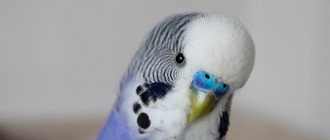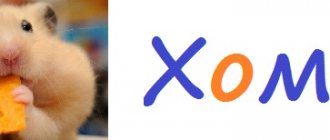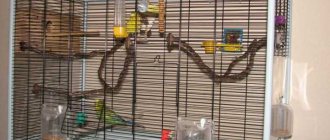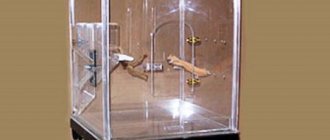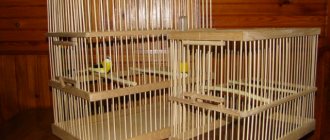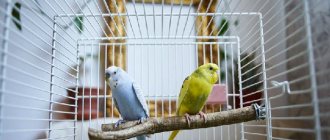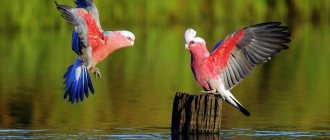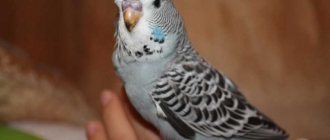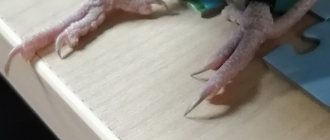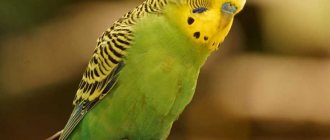- home
- Parrot
- Arrangement
05/23/2019 Parrots bring joy and comfort to your home. In order for a feathered pet to feel good, it needs to equip its home. Feeders and waterers are not all accessories for parrots. There are a lot of useful attributes that a cage can be equipped with. Everything needs to be taken care of in advance so that the bird feels comfortable from the first days and willingly makes contact with humans.
Cage size, what does a parrot need in a cage to feel comfortable?
The very large number of cages that a market or store offers, in our opinion, are not suitable for the house of any living creature. In particular, the cells are “tubes”, which are 30 cm diagonally but one meter high. Birds do not fly high like helicopters , so horizontal space is most important for exercise, not vertical space. Imagine what it's like to live in a closet 3 floors high! Many people choose these cages because they create the illusion of space without taking up space in the room.
A tall and narrow cage is the wrong choice!
The more spacious the enclosure, the more at ease the bird will feel.
However, what if you can't afford a huge cage to comfortably accommodate all the bird furnishings you'd like? There are several rules, following which, you will not cause any inconvenience to the bird.
So which size is preferable?
- For parrots of small and small sizes (canaries, wavy, cockatiels): at least 60 cm x 90 cm . It all depends on what the budgie or cockatiel needs in the cage: just a feeder with a drinker, or also toys and a swing.
- For medium-sized parrots (amazons, cockatoos) - 90 cm x 135 cm
- For large and large (macaws, large cockatoos): 180 cm x 270 cm
Additionally, parrots with crests or long tails need extra height to keep the feathers from touching the top or bottom of the cage . But this basic arithmetic does not take into account the activity levels of different species. For example, the caique or loris are considered relatively small in size, but their extremely high activity levels cause them to use every centimeter of their cage a hundred times a day. Therefore, they need a larger cage.
Advice: do not overload the cage with a huge number of toys, otherwise the house will become like your aunt's living room, filled with an unimaginable amount of furniture, in which it will become difficult to move around.
The best period for mating
The optimal time for successful mating is considered to be the warm season - from the second ten days of May to the beginning of September. During this period, the birds have enough light, green succulent food and temperature background. In the spring, the body of birds experiences severe vitamin deficiency, becomes weakened, and the female is not able to bear strong offspring. The offspring conceived at such a time in most cases are underdeveloped and die while still in the egg.
Birds have every chance for full reproduction in captivity, subject to several basic rules:
- the presence of a spacious aviary with a nest for chicks;
- long daylight hours - up to 15-16 hours (if necessary, artificially extended);
- air temperature – at least 22 degrees;
- nutritious meals including juicy greens at least 2 times a day;
- maintaining home hygiene.
If the female is still too young or, on the contrary, already elderly, it is not worth artificially creating conditions favorable for mating. It should be noted that the mating games of budgerigars are an extremely touching sight.
During this period, the male begins to very tenderly court the female, pleases her in every possible way, takes the most funny poses just so that his beloved will pay attention to him
At these moments, loud singing can be heard, in addition, the male parrot begins to talk - hammering with his beak on a wide variety of objects, including the beak of his female. The seriousness of a male’s intentions can be understood by his desire to feed the female. If breeders begin to notice that a male individual begins to constantly present tidbits to his beloved, therefore, his behavior signals his readiness to take care of her and their future offspring, because it is the male who will be responsible for obtaining food during the period when the female begins to lay and hatch eggs.
It is best to place the young couple in a separate enclosure and monitor their further relationship - if they do not start pecking each other and pulling feathers, then you can count on the chicks to appear soon.
Birds mate quite quickly, so that some owners do not even have time to notice it. Usually the female unfolds to an almost horizontal position, the partner sits on top and very quickly fertilizes her, hugging her with his wings. Depending on the physiological characteristics of the birds, fertilization can be successful after the very first intercourse, or it can last for several weeks.
In order for the process to be more successful, you can resort to a little trick - a couple of weeks before the act, the birds should be given the opportunity to fly as much as possible: during such flights their muscles are strengthened, their appetite increases and their metabolism is normalized.
If the birds achieved their goal the first time, then the parrots still continue their mating for several more days. Usually, it is possible to determine whether the attempt was successful after a few days - the bird begins to engage in “nesting.” At this point, you should take care of installing a nest inside the cage, and also provide the birds with materials that they may need to equip the future incubator.
At first, parrots may not perceive the house, but usually this phenomenon is only temporary: after a couple of days, the female will begin to explore the nest from all sides and put “order” in it at her own discretion. At this moment, the male parrot continues to care for the expectant mother, takes over feeding her and happily chirps at the same time.
What should a safe cage be like?
When choosing an enclosure for a bird, you should pay attention to how safe the cage is and what is the distance between the bars . If the bird manages to stick its head between the bars, then there is a risk of getting stuck and trying to free itself - injury and even death. Because of this, you should be careful when placing a small parrot in a large cage.
The safe distance between the bars of the cage is: for small birds - 1 cm, for medium-sized ones - 2 cm, for large ones - 2.5 cm. Therefore, if you are thinking about what kind of cage a budgie needs, then you should not stop at large sizes, as if We didn’t want space for our pet.
The bird's strong beak is another pitfall. Many cages are made of weak rods that cannot withstand the force of the beak, and this will inevitably lead to the bird bending and biting through the bars of the cage. When assessing a cage in a store, do not forget to run your hand along the inside of the frame in order to notice sharp edges and roughness , which can lead to injury to the pet.
Games
Each owner comes up with his own idea of how to play with a wavy pet. And there are plenty of gaming tools for this, and it’s not difficult to start from them.
The mentioned educational games, which force the parrot to independently obtain food, are also called foraging games, since they are based on the bird’s instinct of searching and obtaining food. The role of the owner in this game is to teach the pet how to do it when it is necessary to achieve a goal by pressing a lever, scrolling a wheel, or gnawing on an obstacle.
Let's play basketball? Smart birds, with the help of humans, can easily master sports toys - basketball courts, rollers, carts, as well as climbing objects, and games with “everyday” overtones.
If you show your parrot how to put some toy in the stroller and roll it around, he will very quickly become interested and master this game. The wavy will like to drop coins into the slot of a small piggy bank, throw rings on the peg, deal with objects of different colors and sizes, sorting them.
He will also quickly master the basketball court: training in throwing the ball will bring pleasure to both man and bird.
They say that parrots, depending on the breed, are equal in development to 2-4 year old children. Therefore, toys, in particular balls, should be selected appropriately so that they can be easily grabbed with paws or beak.
Knowing the character of your pet, you can choose several toys at the pet store that will brighten up your parrot’s leisure time and will also be of interest to the owner.
Or maybe we should ring a bell? Almost all types of parrots like ringing bells and balls; the owner can only choose toys according to the size and abilities of the pet.
From the musical range of toys, just a regular bell, pendants with several “instruments”, and rattles of various sizes are suitable.
Recently, musical interactive toys for birds have appeared. Here you need to train the bird to press a button to extract a melody.
What types of cells are there?
The design of cages for parrots can be very diverse. In general, there are three main styles: open-top, closed and play.
Based on the name, it is clear that the cage has an open top. It is convenient for the bird in that it can return to the cage as needed to absorb food or water. This style of cage is not suitable for beginners or those who cannot get their parrot to return to the cage on time, such as at night.
An open-top cage is convenient for moving birds
Playgrounds. Quite a popular species for those who dote on their birds. You can place nutshells or other toys around the area, depending on what the parrot needs in the cage. And the bird will not fail to taste it on its beak! The bird has a place to roam and do its bird business. However, if the pet is not accustomed to returning “home”, then this can become a problem.
A playground where the parrot will be simply happy!
Standard closed cages. They may have a flat or rounded dome. This type of enclosure does not have a play area or open top.
Regular budgie cage
Advice: the more decor in the cage, the more it distracts attention from the bird itself, which is already quite beautiful and bright. In addition, some cage decorations can cause injury to your pet.
The optimal choice of bird house
The bird must have a cage of optimal size and shape. Pet stores sell products that can satisfy the wishes of any customer. Cells differ in shape, size and internal structure. But not all such models are safe and easy to use.
When choosing a cage, it is recommended to focus on the following parameters:
Form. Experienced ornithologists recommend buying rectangular cages for wavy birds. Angles have a positive effect on the bird’s psyche, as it feels safe. It is advisable to place one side of the cage against the wall, which will allow the pet to relax and calm down if necessary. A round structure is not suitable for wavy birds, as it creates the illusion of space, but it is inconvenient for the bird to climb curved walls.- Dimensions. If you put your parrot in a cage that is too small, it will cause stress because the bird will not have enough free space to move around. This leads to shedding, apathy and decreased appetite. If a person plans to regularly let the bird out for a walk, then the height of the cage may not exceed 45 cm. But if the wavy will spend most of its life inside the cage, then a larger structure is purchased, the height of which starts from 55 cm.
- Material of manufacture . It is not recommended to buy painted or wooden cages. Wood dries out, swells and becomes moldy when exposed to water. Therefore, ideal conditions are created for the development of bacteria and parasites. Stainless steel products are considered the right choice. They should not have sharp corners, protrusions or roughness.
The cage is installed in a well-lit and warm place, but away from heating appliances and electrical devices.
At what height should the cage be mounted?
Some parrots tend to show dominance towards their owners if they are higher up. There are different opinions about why this happens, but there is no scientific evidence on either side of the issue.
The solution to the problem is to tame the parrot. If you teach the bird to sit on your hand every time you let it out of its cage , then the problem will not exist. Receiving praise from you, a gentle pat or a piece of treat is the best pleasure for a bird!
By the way, keeping your bird below eye level at all times is not always a guarantee of good behavior, but some people really think so!
Appropriate place
Before buying a birdhouse, it’s a good idea to think about where to put it. The arrangement of a cage for a budgie stops within the first or two days at most. The new tenant, having taken the initial steps into the family, will feel awkward in the new environment. Getting used to the people around you and an unfamiliar environment can cause your pet stress. Therefore, at the beginning of dating, moving around your home will only add excitement.
When choosing a suitable location for a steel structure, it is important to consider several factors:
- quiet, calm room;
- absence of drafts;
- presence of sunlight, but without direct contact;
- comfortable temperature microclimate;
- permissible air humidity.
It follows from this that the bird’s housing structure can under no circumstances be located in the kitchen, where excess moisture and evaporation will serve as a source of poisoning and illness for the parrot. An important aspect of the installation is to calculate the height of the house from the point of view of the psychological interaction between the owner and the animal. The optimal value is when the bird is just below your eye level. Then there will be a correct understanding of who is in charge in the house. What will contribute to effective training and education.
What cell color to choose
The bars of most cages are powder coated or made of stainless steel. Powder coating means that the metal is spray painted. These parrot cages can be very attractive because owners can choose a cage of any color that matches the design of the apartment and the color of the bird.
It is better to choose unpainted cells from which the paint will not peel off over time.
However, it is worth understanding that sooner or later you will notice that the paint has peeled off, and you will either need to put up with it or repaint the cage. The best choice is a stainless steel frame . Such cells are durable. However, they are also expensive. However, in the future you will spend less money on their maintenance than on a standard painted house.
Home for a pet
It is better to buy a rectangular home. The first item the owner buys is a cage. Since parrots have a negative attitude towards constantly moving their house, it is necessary to decide in which place it will stand. The cage should be spacious, easily visible and allow natural light to pass through.
It is advisable to choose a rectangular shape for the home, in which the bird feels protected. All-metal products are very popular; they are durable, easy to clean and safe to maintain. The cage is installed away from heating and household appliances. Avoid drafts.
Why a good cage is important
You're probably familiar with the story where one guy realizes his dream and buys himself a hyacinth macaw, but he doesn't have enough money to buy a cage, and he puts the parrot in the wrong box or a cage intended for another animal. While the owner is at work, the parrot destroys the cage and begins to damage furniture and other interior items. Don't repeat his mistakes!
A large parrot needs a cage with thick bars
If you love a pet, you will probably want the best for it, let's figure out what a parrot should have in its cage.
Perches and swings
We don't always think about the comfort for the paws of our feathered friends. But parrots use them 24 hours a day, even when they sleep. It is best if the cage can accommodate several perches of different sizes. Natural wooden branch perches for parrots are preferable to plastic ones , because... have natural roughness. Plastic perches are too smooth and uncomfortable for the bird. In this case, the accessory can be additionally sanded to give it an uneven surface. Sisal ropes are comfortable for the bird, but you need to keep an eye on the surface so that they do not become too loose so that the parrot can hang on. You should also choose a swing from affordable and high-quality materials: a round fabric ring with a perch for a parrot.
You can equip the cage with natural wood
Many owners prefer swings made of stainless steel, rubber and rings with impact-resistant plastic. If you choose rubberized products, you should make sure that the parrot does not bite or swallow pieces; If you still notice a bad habit, it is better to remove this accessory from the cage.
Parrot toys
Many bird owners like to pamper their pets with stimulating toys in order to diversify the bird's life and get pleasure from watching a parrot, which most often is not deprived of intelligence. Toys are made from a wide variety of materials: wood, acrylic, stainless steel, nylon, polyvinyl chloride, cotton and sisal, fabric, rubber, paper, tanned leather, husks, dried palm leaves and other organic materials. They can be presented in different forms: bells, beads, rings, coconut shells . A wide variety of shapes, colors, combinations of materials.
The parrot will definitely like the swing
There are various toys for parrots:
- toys related to the cage in one way or another;
- rotating toys;
- cuddling toys;
- puzzle toys;
- chew toys;
- jumping toys;
- cluster toys;
- weight loss toys;
- toys with noise;
- interactive toys;
- Kids toys.
Parrots love almost all of them. They know they can do whatever they want with their toys. This is an important part of the emotional and mental health of birds - permission to manipulate and destroy their personal belongings.
Curious birds almost immediately strive to explore the object as soon as a new toy falls into their tenacious paws. Parrots don't always need fancy toys - sometimes a bolt attached to a thread is enough for them to explore and try it on their beak. Clean parrot sticks (usually from citrus trees ) are a great way to keep your bird in a cage. If you decide to make your own bird toys, be sure to use safe materials.
Video: how to make a ring for a parrot with your own hands
Among the additional accessories, if space allows, you can put a stone and chalk for the parrot in the cage.
Feeder and drinker for a parrot
These two accessories are essential parts of any parrot cage. If the size of the cage allows, then it is best to use three feeders for parrots: a water bowl, a bowl for dry foods (for example, grains), and a feeder for wet foods (for example, vegetables). Food bowls come in a variety of materials. Parrot feeders made of high-impact plastic, ceramic or stainless steel are safe to feed, but it is best to avoid galvanized metal bowls due to the potential for heavy metal toxicity.
Feeder and drinker
Parrots should always have access to clean, filtered water. Quite often, large parrots, such as Amazons, confuse the water bowl with the toilet, so you need to change the water several times a day. For such parrots, he recommends purchasing bowls with a “hood” or installing special closed drinking bowls , as in the photo. Such drinking bowls for parrots, despite the fact that they do not appear to be dirty, require changing the water at least once a day.
Video: automatic feeder for parrots
For large cages, many owners buy a special mesh stand . You can periodically place slices of vegetables on such a grid: corn, carrots, cherry tomatoes, broccoli; pea pod. Green beans, an orange slice, a slice of banana, Brussels sprouts, pieces of sweet potato, zucchini - all this will certainly find its use.
Of course, more treats end up at the bottom of the cage, but still the parrot spends time with pleasure and eats those pieces that it considers necessary.
Correct arrangement
Some designs are sold complete with drinkers, feeders and other elements. They usually have an unattractive appearance and low quality, so it is advisable to replace them with more suitable products.
How to position the perches
A cage is a place for a parrot to permanently live, so when choosing equipment, the convenience for the bird is taken into account, and not the aesthetic tastes of the owner. Only really necessary elements are purchased, so it is not recommended to clutter the space with a large number of unnecessary parts.
Perches are mandatory items in any cage, as wavy birds use them all the time. They are used for the parrot's movement and sleep. With the correct choice of perches, the preservation of the health of the legs is guaranteed, since it is low-quality crossbars that often become the cause of diseases of the legs or even the death of the bird. Perches are selected that are not only convenient for use, but also have optimal sizes for massaging the paws.
The cages are initially equipped with crossbars made of wood, plastic or composite materials.
But they are not always convenient and safe, so it is recommended to purchase suitable products yourself, taking into account the recommendations:
If natural wood is used, the branches are polished and treated with protective compounds, but they should not be made too smooth. It is allowed to leave a little bark, which the birds will peck with pleasure. The diameter of the crossbars varies from 15 to 20 mm.
The perches are placed in such a way that the bird can move freely inside the cage. One crossbar should be located next to the feeder and drinker for easy access to water and food. It is not recommended to use too many perches as this will create a cramped and uncomfortable space.
Where are the feeders installed?
Ornithologists recommend using several feeders at once, since one product is intended for dry food, and the second is used for cereals, fruits or vegetables. Treats can be placed in a flat plate, which is placed at the bottom of the cage.
The most convenient are hanging products that are attached to the mesh. There is a container with food located outside, so it is easy to clean, and you don’t have to always open the cage door to feed the wavy.
It is advisable to purchase a large feeder, which will allow the birds to easily dig through the grains to find treats.
Drinking bowls
They can be automatic, open or closed. Usually, a hanging structure is selected that is fixed to the cage mesh, and when used, moisture does not get inside the cage. If you choose a closed model, the water remains fresh for a long time.
Automatic waterers are expensive and break down quickly, so they are usually used if you need to go away for several days, leaving your parrot alone in a cage.
Do I need to equip it with toys?
They are required not only for entertainment, but also for the optimal development of the bird. Wavys are considered smart birds, so they quickly begin to get bored in the absence of play. If a person cannot give his pet too much attention and time, then he should purchase toys.
But it is not recommended to use too many elements, so the recommendations of the breeders are taken into account:
Does a parrot need a mirror in its cage?
In nature, parrots live in whole flocks. At home, the parrot is looking for a companion. In your absence, he will not be at all lonely if you hang a mirror in the cage. The parrot will most likely perceive the reflection in the mirror as a second bird.
The mirror is an ambiguous object in the cage
There are several dangers here:
- he may start pecking at the mirror . The materials used to make a parrot mirror can be dangerous. Therefore, when choosing, pay attention to safe materials, for example, a plexiglass mirror.
- Parrots, like people, differ in character and disposition. Not all birds may like the presence of a competitor in the cage (he will see the competitor in the reflection), so if you notice that the bird is irritable, it is better to remove the mirror from the cage.
- or maybe...see your other half in the reflection!
Video: the real story about the mirror for parrots
